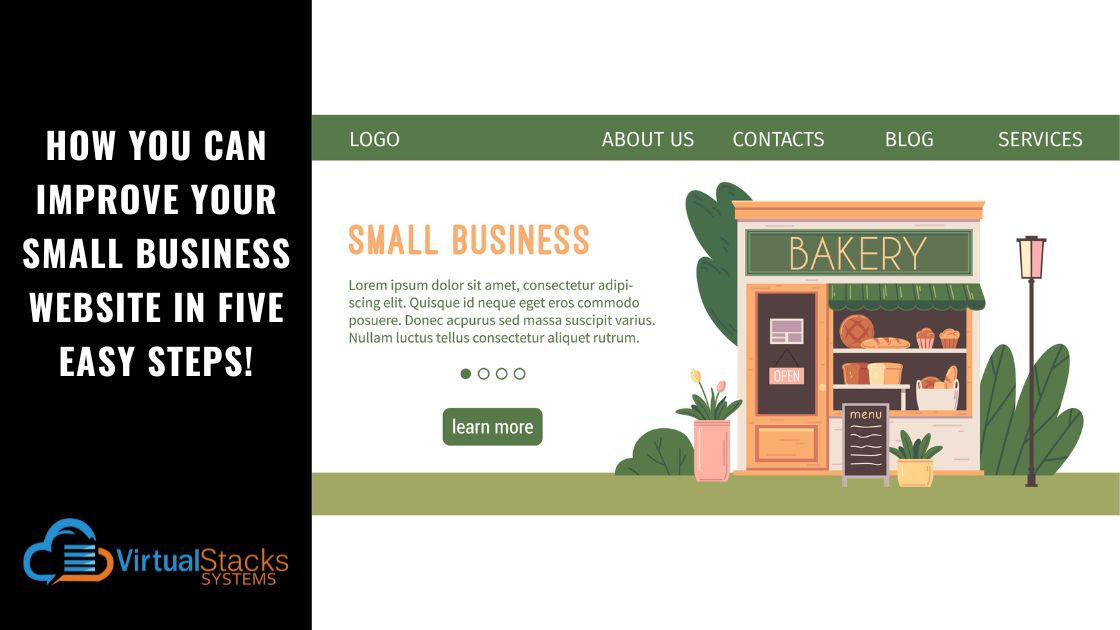
05 Aug How You Can Improve Your Small Business Website in Five Easy Steps!
If you’re the owner of a small business, you may not think about its website very often – especially if your business is brick-and-mortar, without e-commerce. But assuming that your site is humming along just fine because you’re satisfied with your foot traffic and sales could mean you’re missing out on potentially more customers! Here are five steps you should implement to make sure your website is working at its smartest and hardest to make money for you!
1. Optimize for mobile devices
With over half of global web traffic coming from mobile devices, a responsive design that adapts to various screen sizes is critical. Google even prioritizes mobile-friendly sites in its search rankings.
Quick tips:
- Ensure your website automatically adjusts to fit different screen sizes.
- Use large, easily clickable buttons for navigation on smaller screens.
- Prioritize fast loading times for mobile users.
2. Enhance the user experience
A website that’s easy to navigate, understand and use helps build trust and keeps visitors engaged. Simplify navigation by limiting top-level menu items (e.g., to five to seven categories), using clear labels and organizing content logically. Incorporate elements like social proof (testimonials, reviews) and ensure content is easy to read with headings, short paragraphs and bullet points.
For example, our blog post – “Seven Elements Your Website’s Home Page Needs” – covers the importance of the following:
- Clear, logical navigation.
- Descriptive headlines and sub-headlines.
- High-quality images relevant to your business.
- Highly readable typography.
- An overview of your business, services and features.
- Calls-to-action (CTA).
- Social media icons that link to your social media platforms.
3. Boost your visibility with SEO
Even the most well-designed website needs to be discoverable by search engines.
Focus on:
- Keyword research: Identify relevant keywords your audience uses to search for your products or services.
- High-quality content: Create engaging and informative content that answers customer questions and naturally incorporates keywords.
- On-page optimization: Optimize titles, meta descriptions, headings and images with keywords to help search engines understand your content.
- Local SEO: Claim your Google Business Profile to improve visibility in local search results.
Our blog post – “How to Optimize Your Google Business Profile” – provides great tips on making the most of this valuable free service.
4. Include clear calls to action
This is so important, we mentioned it twice! A CTA encourages visitors to take a desired action, such as “Buy Now,” “Sign Up,” or “Contact Us.”
Tips for effective CTAs:
- Use strong, action-oriented verbs.
- Make CTAs visually distinct and easy to find (e.g., use contrasting colors).
- Position CTAs strategically, potentially above the fold or after a compelling section of content.
Our blog post – “X Marks the Spot: Create Call-to-Action Buttons that Get Leads” – covers this topic in detail.
5. Regularly maintain and update your website
A website should be a dynamic asset, not a static brochure. Regularly update content, check for broken links, ensure security updates are applied, and monitor performance using analytics tools.
Consider the following:
- Fresh content: Regularly add new blog posts, updates about your business, or refresh existing content to keep it relevant and engaging.
- Website audits: Periodically review your site for usability, content quality, SEO performance, and technical issues.
- Utilize analytics: Use tools like Google Analytics and Google Search Console to track visitor behavior and identify areas for improvement.
Adding a blog to your website is an effective way to provide fresh content. As our blog post – “Why Your Website Needs a Blog” points out:
“Google rewards websites that add content on a regular basis with better visibility. Unless you have an e-commerce site with a constantly changing inventory, your business probably has little reason to update its home page or add web pages (although we do advocate for landing pages). A blog with posts published on a weekly basis lets Google know your website is a living, dynamic entity worthy of notice – giving it more reasons to index your website more often.”
Moreover, a blog helps your website rank for long-tail search queries – which are searches based on natural language or questions users enter, rather than single keywords. So if your site has a blog post titled, “How You Can Identify a Quality Widget,” and someone asks Google how to identify a quality widget, your website has a better chance of ranking high in the SERPs. It’s a well-known fact in the SEO world that 75% of users don’t scroll beyond the first page of search results.
The Take-Home Message and Our Blatant Self-Promotion
Improving your business’s website to drive more traffic and generate more business doesn’t need to be a daunting task. But, of course, having the right full-service digital agency on hand can make the job faster, and ensure that all is done with optimal expertise. Our dedicated Virtual Stacks Systems team provides comprehensive digital marketing services that include website design, website redesign, SEO services, content writing, pay-per-click marketing and so much more! Every small business is unique, and so are our solutions. We are ready to be your partner in success!
Contact us to learn more and get started!
